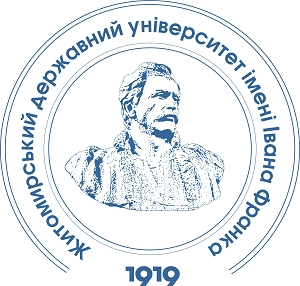ЕФЕКТИВНІСТЬ КОМПЛЕКСНОГО ЗАСТОСУВАННЯ СИДЕРАТІВ ІЗ БІОДОБРИВАМИ ЗА ВИРОЩУВАННЯ КУКУРУДЗИ НА ЗЕРНО
DOI:
https://doi.org/10.32782/naturaljournal.12.2025.26Ключові слова:
сидерація, редька олійна, гірчиця біла, біоорганічні добрива, забур’яненість, урожайністьАнотація
Визначено для України, що з позиції формування оптимізованих систем удобрення актуальним завданням є адаптація сидеральних систем удобрення завдяки використанню хрестоцвітих видів рослин-сидератів – редьки олійної та гірчиці білої, які адаптовані до ґрунтово-кліматичних умов Лісостепової зони. Саме даний спосіб удобрення, у поєднані з мінеральним фоновим живленням, забезпечує реалізацію принципів екологізації та біологізації, сприяє поверненню до адаптивних технологій ґрунтозбереження та ґрунтореабілітації.За багаторічний період досліджень (2022–2024 роки) визначено ефективність застосування сидеральної системи із включенням редьки олійної та гірчиці білої на фоні застосування біодобрива Органік баланс у системі удобрення кукурудзи на зерно на сірих лісових ґрунтах, типових для ґрунтового покриву зони Лісостепу Правобережного.За результатами досліджень визнано доцільним за вирощування кукурудзи на зерно варіант сидерації, який передбачає застосування біодобрива Органік баланс у нормі 2 л/га у поєднанні із загортанням, шляхом оранки, подрібненої маси редьки олійної та гірчиці білої загальною масою 18 т/га на фоні удобрення в нормі N60P60K60. Застосування такого технологічного варіанту дозволило скоротити загальний рівень забур’яненості кукурудзи на 49,4% (сира маса бур’янів) та на 55,0% (суха маса бур’янів) та забезпечило досягнення врожайності на рівні 8,18 т/га із приростом до контролю без сидерації та застосування біодобрива 21,2%.
Посилання
Badu-Apraku B., Fakorede M.A.B., Menkir A., Sanogo D. Conduct and Management of Maize Field Trials. IITA, Ibadan, 2012. 59 p.
Berezyuk S., Pryshliak N., Zubar І. Ecological and economic problems of fertilizers application in crop production. Bulgarian Journal of Agricultural Science. 2021. Vol. 27. № 1. P. 29–37.
Bublitz T.A., Kemper R., Müller P., Kautz T., Döring T.F., Athmann M. Relating Profile Wall Root-Length Density Estimates to Monolith Root-Length Density Measurements of Cover Crops. Agronomy. 2022. Vol. 12. P. 48. https://doi.org/10.3390/agronomy12010048.
Deus T.R.V., de Giongo V., Salviano A.M., Santana M. da S., Silva V.C., da Santos T.C. dos. Selection of green manures to provide ecosystem services in a semi-arid environment. Revista Brasileira de Ciências Ambientais. 2022. Vol. 57. № 3. P. 409–421. https://doi.org/10.5327/Z2176-94781268.
dos Santos Nascimento G., de Souza T.A.F., da Silva L.J.R. Soil physico-chemical properties, biomass production, and root density in a green manure farming system from tropical ecosystem, North-eastern Brazil. Journal of Soils and Sediments. 2021. Vol. 21. P. 2203–2211. https://doi.org/10.1007/s11368-021-02924-z.
Drescher G.L., Slaton N.A., Roberts T.L., Smartt A.D. Corn yield response to phosphorus and potassium fertilization in Arkansas. Crop, Forage & Turfgrass Mgmt. 2021. Vol. 7. P. e20120. https://doi.org/10.1002/cft2.20120.
Duff J., van Sprang C., O’Halloran J., Hall Z. Guide to Brassica Biofumigant Cover Crops Managing soilborne diseases in vegetable production systems. Horticulture Innovation through VG16068 Optimising cover cropping for the Australian vegetable industry. State of Queensland. Department of Agriculture and Fisheries. 2020. 40 p.
Fan F., Zhang H., Alandia G., Luo L., Cui Z., Niu X., Liu R., Zhang X., Zhang Y., Zhang F. Long- Term Effect of Manure and Mineral Fertilizer Application Rate on Maize Yield and Accumulated Nutrients Use Efficiencies in North China Plain. Agronomy. 2020. Vol. 10. P. 1329. https://doi.org/10.3390/agronomy10091329.
Gao X., He Y., Chen Y., Wang M. Leguminous green manure amendments improve maize yield by increasing N and P fertilizer use eciency in yellow soil of the Yunnan-Guizhou Plateau. Front. Sustain. Food Syst. 2024. Vol. 8. P. 1369571. https://doi.org/10.3389/fsufs.2024.1369571.
Gentsch N., Riechers F., Boy J., Schwenecker D., Feuerstein U., Heuermann D., Guggenberger G. Cover crops improve soil structure and change organic carbon distribution in macroaggregate fractions. Soil. 2024. № 10. P. 139–150. https://doi.org/10.5194/soil-10-139-2024.
Honcharuk I., Tokarchuk D. Review of the European Experience of AIC Development and the Role of Green Technologies in the Modernisation of This Process. Baltic Journal of Economic Studies. 2024. Vol. 10. № 5. P. 155–165. https://doi.org/10.30525/2256-0742/2024-10-5-155-165.
Hudek C., Putinica C., Otten W., De Baets S. Functional root trait-based classification of cover crops to improve soil physical properties. European Journal of Soil Science. 2022. Vol. 73. № 1. P. e13147. https://doi.org/10.1111/ejss.13147.
Hlushchenko L., Olepir R., Len O., Soroka Y., Saidak R. Corn for grain in continuous growing under different fertilizer systems and weather conditions. Land Reclamation and Water Management. 2024. № 1. P. 91–97. https://doi.org/10.31073/mivg202401-378.
Kemper R. Root growth of sole and mixed cover crops in organic farming. Dissertation for the attainment of the degree Doctor of Agricultural Sciences. Institute of Crop Science and Resource Conservation. Department of Agroecology and Organic Farming. Bonn, 2024. 195 p.
Kucerik J., Brtnicky M., Mustafa A., Hammerschmiedt T., Kintl A., Sobotkova J., Alamri S., Baltazar T., Latal O., Naveed M., Malicek O., Holatko J. Utilization of Diversified Cover Crops as Green Manure-Enhanced Soil Organic Carbon, Nutrient Transformation, Microbial Activity, and Maize Growth. Agronomy. 2024. Vol. 14. № 9. P. 2001. https://doi.org/10.3390/agronomy14092001.
Lei B., Wang J., Yao H. Ecological and Environmental Benefits of Planting Green Manure in Paddy Fields. Agriculture. 2022. Vol. 12. № 2. P. 223. https://doi.org/10.3390/agriculture12020223.
Li P., Jia L., Chen Q., Zhang H., Deng J., Lu J., Xu L., Li H., Hu F., Jiao J. Adaptive evaluation for agricultural sustainability of different fertilizer management options for a green manure- maize rotation system: Impacts on crop yield, soil biochemical properties and organic carbon fractions. Science of The Total Environment. 2024. Vol. 908. P. 168170. https://doi.org/10.3390/agriculture12020223.
Naher U.A., Biswas J.C., Maniruzzaman M., Khan F.H., Sarker M.I.U., Jahan A., Hera M.H.R., Hossain M.B., Islam A., Islam M.R., Kabir M.S. Bio-Organic Fertilizer: A Green Technology to Reduce Synthetic N and P Fertilizer for Rice Production. Frontiers in Plant Science. 2021. № 12. P. 602052. https://doi.org/10.3389/fpls.2021.602052.
Olfs H.-W. Organic Fertilization in Maize Cropping Systems: Measures to Reduce N Losses. Agronomy. 2021. Vol. 11. P. 793. https://doi.org/10.3390/agronomy11040793.
Pál V., Zsombik L. Effect of Common Vetch (Vicia sativa L.) Green Manure on the Yield of Corn in Crop Rotation System. Agronomy. 2024. Vol. 14. P. 19. https://doi.org/10.3390/agronomy14010019.
Pimentel M.L., Reis I.M.S., Romano M.L.P.C., de Castro J.S., Vildoso C.I.A., Gasparin E., de Sia E.F., de Sousa L.S. Green manure, a sustainable strategy to improve soil quality: A case study in an oxisol from Northern Brazil. Australian Journal of Crop Science. 2023. Vol. 17. № 6. P. 488–497. https://doi.org/10.21475/ajcs.23.17.06.p3832.
Qi Z., Liu C., Wang Y., Zhang Z., Sun X. Design and Experimentation of Targeted Deep Fertilization Device for Corn Cultivation. Agriculture. 2024. Vol. 14. P. 1645. https://doi.org/10.3390/agriculture14091645.
Saleem M., Pervaiz Z.H., Contreras J., Lindenberger J.H., Hupp B.M., Chen D., Zhang Q., Wang C., Iqbal J., Twigg P. Cover crop diversity improves multiple soil properties via altering root architectural traits. Rhizosphere. 2020. Vol. 16. P. 100248. https://doi.org/10.1016/j.rhisph.2020.100248.
Tokarchuk D., Pryshliak N., Berezyuk S., Tokarchuk O. Advancing sustainable reconstruction in Ukraine after full scale invasion: utilizing a “green” economic approach and essential guidelines for successful implementation. Polityka Energetyczna. 2024. Vol. 27. № 2. P. 71–88. https://doi.org/10.33223/epj/185209.
Tsytsiura Y. Potential of oilseed radish (Raphanus sativus l. var. oleiformis Pers.) as a multi- service cover crop (MSCC). Agronomy Research. 2024a. Vol. 22. № 2. P. 1026–1070. https://doi.org/10.15159/AR.24.086.
Tsytsiura Y. Evaluation of Ecological Adaptability of Oilseed Radish (Raphanus sativus L. var. oleiformis Pers.) Biopotential Realization in the System of Criteria for Multi-Service Cover Crop. Journal of Ecological Engineering. 2024b. Vol. 25. Iss. 7. Р. 265–285. https://doi.org/10.12911/22998993/188603.
Wang Y., Cao Y., Feng G., Li X., Zhu L., Liu S., Coulter J.A., Gao Q. Integrated Soil – Crop System Management with Organic Fertilizer Achieves Sustainable High Maize Yield and Nitrogen Use Efficiency in Northeast China Based on an 11-Year Field Study. Agronomy. 2020. Vol. 10. P. 1078. https://doi.org/10.3390/agronomy10081078.
Wei Z., Ying H., Guo X., Zhuang M., Cui Z., Zhang F. Substitution of Mineral Fertilizer with Organic Fertilizer in Maize Systems: A Meta-Analysis of Reduced Nitrogen and Carbon Emissions. Agronomy. 2020. Vol. 10. P. 1149. http://doi.org/10.3390/agronomy10081149.
Wong J. Handbook of statistical analysis and data mining applications. Cambridge : Academic Press, 2018, 589 p. http://doi.org/10.1016/C2012-0-06451-4.






